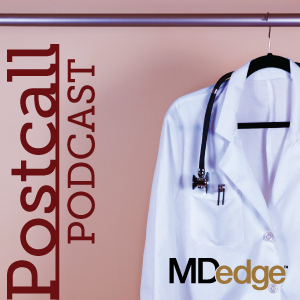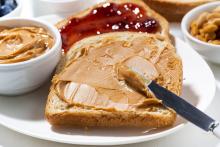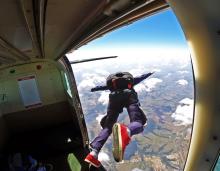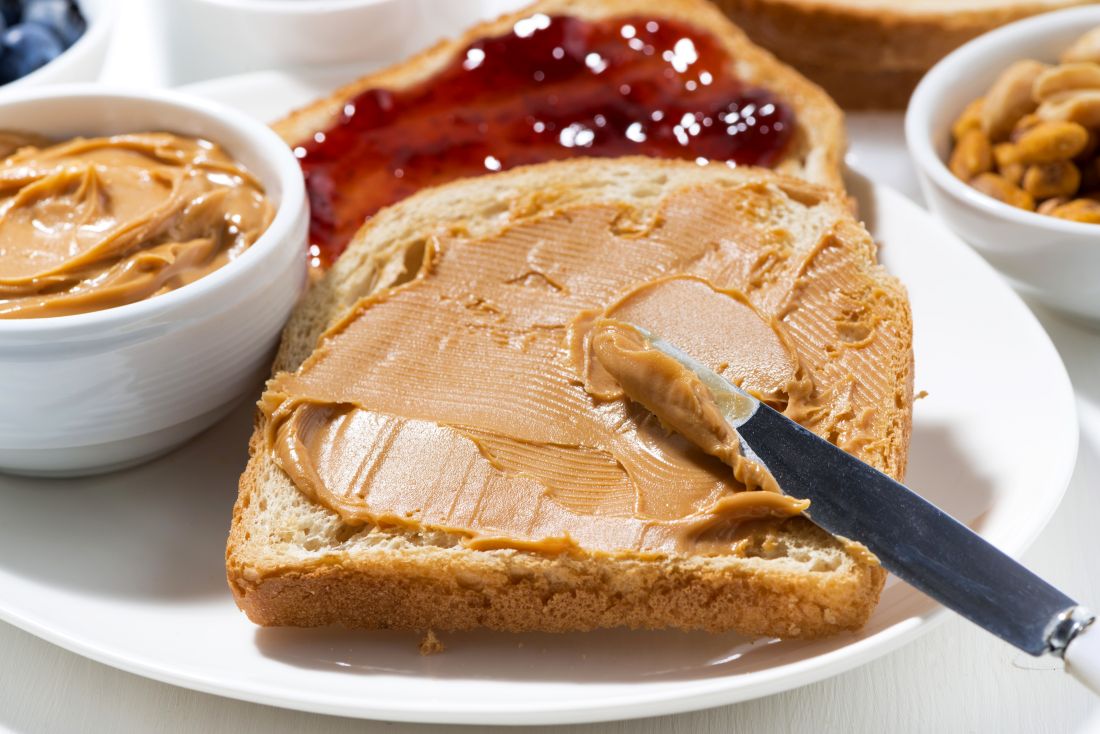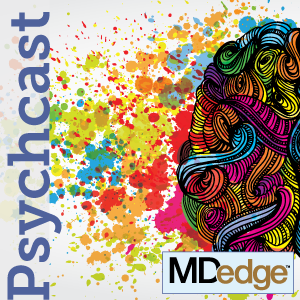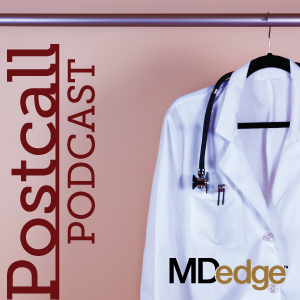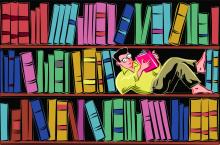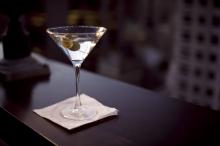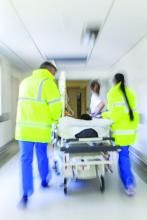User login
Raymond Barfield Part I
Now, he joins the Postcall Podcast to discuss why he’s back, what he’s working on to prevent burnout, and how he wants to remake pre-med education. You can read more from Dr. Barfield’s story here.
Apple Podcasts
Google Podcasts
Spotify
Now, he joins the Postcall Podcast to discuss why he’s back, what he’s working on to prevent burnout, and how he wants to remake pre-med education. You can read more from Dr. Barfield’s story here.
Apple Podcasts
Google Podcasts
Spotify
Now, he joins the Postcall Podcast to discuss why he’s back, what he’s working on to prevent burnout, and how he wants to remake pre-med education. You can read more from Dr. Barfield’s story here.
Apple Podcasts
Google Podcasts
Spotify
Putting up with abusive patients? That’s not for me.
I’ll put up with a lot in this practice, but I will not tolerate mistreatment of my staff.
Rudeness, while never pleasant, is generally tolerated. Some people just have that sort of personality. Others may be having a crappy day for unrelated reasons. We all have those.
But those who are intentionally abusive of my hardworking assistants aren’t going to get very far here. I have no problem telling them to go elsewhere. (This doesn’t include those with neurologic reasons for such behavior.)
Some doctors are more willing to put up with this than I am. I once shared space with one who routinely told his staff to ignore abusive behaviors. He didn’t want to turn away any potential revenue or risk angering a referring doctor.
I take another view. Life is short, and medical practice is, by nature, hectic. I have little enough time to care for the patients who genuinely appreciate what my staff and I are trying to do for them. People who are abusive and belligerent can find another doctor who’s willing to put up with it. I won’t.
My staff and I don’t expect to be thanked. We all signed up to work here. But we also try to treat patients with concern and respect, and ask the same courtesy in return. Isn’t that the golden rule?
Abusive patients are difficult to deal with, time consuming, and contribute to staff burnout. The two awesome women who work here deserve better than that. If they’re not happy, I’m not happy. All it takes is one bad person to throw the day off kilter and sometimes affect the care of the next patient in line. That person deserves better, too.
Some will argue that, as a doctor, I should care for all who need my help. In the hospital, I do. I understand that people there generally are scared and hurting and do not want to be there. But in my office I expect at least some degree of civility. We have to be at our best for each person who comes in, and having patients we can work with on a polite level helps.
There’s enough insanity in this job on a good day. People who intentionally try to make it worse aren’t welcome in my little world.
Dr. Block has a solo neurology practice in Scottsdale, Ariz.
I’ll put up with a lot in this practice, but I will not tolerate mistreatment of my staff.
Rudeness, while never pleasant, is generally tolerated. Some people just have that sort of personality. Others may be having a crappy day for unrelated reasons. We all have those.
But those who are intentionally abusive of my hardworking assistants aren’t going to get very far here. I have no problem telling them to go elsewhere. (This doesn’t include those with neurologic reasons for such behavior.)
Some doctors are more willing to put up with this than I am. I once shared space with one who routinely told his staff to ignore abusive behaviors. He didn’t want to turn away any potential revenue or risk angering a referring doctor.
I take another view. Life is short, and medical practice is, by nature, hectic. I have little enough time to care for the patients who genuinely appreciate what my staff and I are trying to do for them. People who are abusive and belligerent can find another doctor who’s willing to put up with it. I won’t.
My staff and I don’t expect to be thanked. We all signed up to work here. But we also try to treat patients with concern and respect, and ask the same courtesy in return. Isn’t that the golden rule?
Abusive patients are difficult to deal with, time consuming, and contribute to staff burnout. The two awesome women who work here deserve better than that. If they’re not happy, I’m not happy. All it takes is one bad person to throw the day off kilter and sometimes affect the care of the next patient in line. That person deserves better, too.
Some will argue that, as a doctor, I should care for all who need my help. In the hospital, I do. I understand that people there generally are scared and hurting and do not want to be there. But in my office I expect at least some degree of civility. We have to be at our best for each person who comes in, and having patients we can work with on a polite level helps.
There’s enough insanity in this job on a good day. People who intentionally try to make it worse aren’t welcome in my little world.
Dr. Block has a solo neurology practice in Scottsdale, Ariz.
I’ll put up with a lot in this practice, but I will not tolerate mistreatment of my staff.
Rudeness, while never pleasant, is generally tolerated. Some people just have that sort of personality. Others may be having a crappy day for unrelated reasons. We all have those.
But those who are intentionally abusive of my hardworking assistants aren’t going to get very far here. I have no problem telling them to go elsewhere. (This doesn’t include those with neurologic reasons for such behavior.)
Some doctors are more willing to put up with this than I am. I once shared space with one who routinely told his staff to ignore abusive behaviors. He didn’t want to turn away any potential revenue or risk angering a referring doctor.
I take another view. Life is short, and medical practice is, by nature, hectic. I have little enough time to care for the patients who genuinely appreciate what my staff and I are trying to do for them. People who are abusive and belligerent can find another doctor who’s willing to put up with it. I won’t.
My staff and I don’t expect to be thanked. We all signed up to work here. But we also try to treat patients with concern and respect, and ask the same courtesy in return. Isn’t that the golden rule?
Abusive patients are difficult to deal with, time consuming, and contribute to staff burnout. The two awesome women who work here deserve better than that. If they’re not happy, I’m not happy. All it takes is one bad person to throw the day off kilter and sometimes affect the care of the next patient in line. That person deserves better, too.
Some will argue that, as a doctor, I should care for all who need my help. In the hospital, I do. I understand that people there generally are scared and hurting and do not want to be there. But in my office I expect at least some degree of civility. We have to be at our best for each person who comes in, and having patients we can work with on a polite level helps.
There’s enough insanity in this job on a good day. People who intentionally try to make it worse aren’t welcome in my little world.
Dr. Block has a solo neurology practice in Scottsdale, Ariz.
Transplanted food allergies, cavity-check hospital bills, and cancer-blocking houseplants
One lung, please (Hold the food allergy)
Is an organ transplant really worth the risk of developing a food allergy? Probably (er, definitely), but it still totally stinks. A 68-year-old woman suffered an allergic reaction to an innocent peanut butter and jelly sandwich earlier this year, after spending decades of eating peanut butter with no problem. Turns out, her lung transplant donor was allergic to peanuts and unfortunately passed that curse onto her. At least he wasn’t lactose intolerant – can you imagine suddenly being unable to eat cheese?!
Passing on allergies via transplant is extremely rare; there are only about five cases of transplanted peanut allergies. The use of tacrolimus, an immunosuppressive drug, can also increase the risk of contracting food allergies post transplant. Luckily, the woman in question was still in the hospital when she began experiencing symptoms of an allergy attack, and doctors were able to correctly identify and punish the offending sandwich.
A debt of ingratitude
Medical personnel generally don’t get involved in searches for illegal drugs, but physicians at St. Joseph’s Hospital Health Center in Syracuse, N.Y., found themselves in just such a position. Because the police had a court order. Because the suspect said that he’d hidden drugs … in his rectum.
An x-ray had shown no evidence of drugs, but physicians there performed a sigmoidoscopy on Torrence Jackson after a hospital lawyer said “that a search warrant required the doctors to use ‘any means’ to retrieve the drugs,” according to a recent Syracuse.com report of the incident, which took place on Oct. 16, 2017. The sigmoidoscopy confirmed the x-ray finding, or lack thereof, and drug charges against Mr. Jackson eventually were thrown out.
The health care system, however, did its part to put a cherry on top of the situation: The hospital billed Mr. Jackson $4,595.12 for the procedure, and then said it would turn the matter over to a debt collector when he refused to pay.
Cancer-blocking plants?
All hail the GMOs! Researchers from the University of Washington have used genetic modification on a houseplant to turn it into a lean, green, chloroform-eatin’ machine. These mad scientists modified devil’s ivy to pull chloroform (found in chlorinated water) and benzene (found in gasoline) from the air and use them for plant growth.
These compounds are often so small they can’t be caught by air filters but can still cause damage – exposure to chloroform and benzene has been linked to cancer. Now, you can lessen your risk of cancer and enjoy some nice greenery in your home. Researchers have also started working on a new genetic modification to remove formaldehyde compounds from the air. It looks like the future of health is all about plants!
It must be true – it’s in a study
There’s untested, widely accepted truth, and then there’s empirically tested truth demonstrated in a rigorous scientific trial. Untested, widely accepted truth in point: Compared with using a simple backpack, parachute use is more likely to prevent death or major traumatic injury when leaping from an aircraft. Of course, no one’s ever done a study to prove it. Because, duh. Also, institutional review boards. Also, lawyers.
Until now.
Robert Yeh, M.D., of Harvard Medical School, and his colleagues began recruiting for just such a research trial while flying commercially. Few seat mates took up their randomized-to-parachute-or-backpack offer. That forced Dr. Yeh to recruit randomized participants from among fellow academics. Twenty-three research-minded souls agreed to make the leap for scientific progress from either a biplane or a helicopter, thereby making the study “Parachute use to prevent death and major trauma when jumping from aircraft: randomized controlled trial” a BMJ-published reality.
The results? “Our groundbreaking study found no statistically significant difference in the primary outcome between the treatment and control arms.”
How can the scientific method explain such a skydiving miracle? Because each and every study participant leaped ... 2 feet. From a parked biplane or helicopter.
“Although we can confidently recommend that individuals jumping from small stationary aircraft on the ground do not require parachutes, individual judgment should be exercised when applying these findings at higher altitudes.” It’s also possible the study authors are suggesting individual judgment should have a parachute, not a backpack, when physicians dive into a study’s scientific methodology.
One lung, please (Hold the food allergy)
Is an organ transplant really worth the risk of developing a food allergy? Probably (er, definitely), but it still totally stinks. A 68-year-old woman suffered an allergic reaction to an innocent peanut butter and jelly sandwich earlier this year, after spending decades of eating peanut butter with no problem. Turns out, her lung transplant donor was allergic to peanuts and unfortunately passed that curse onto her. At least he wasn’t lactose intolerant – can you imagine suddenly being unable to eat cheese?!
Passing on allergies via transplant is extremely rare; there are only about five cases of transplanted peanut allergies. The use of tacrolimus, an immunosuppressive drug, can also increase the risk of contracting food allergies post transplant. Luckily, the woman in question was still in the hospital when she began experiencing symptoms of an allergy attack, and doctors were able to correctly identify and punish the offending sandwich.
A debt of ingratitude
Medical personnel generally don’t get involved in searches for illegal drugs, but physicians at St. Joseph’s Hospital Health Center in Syracuse, N.Y., found themselves in just such a position. Because the police had a court order. Because the suspect said that he’d hidden drugs … in his rectum.
An x-ray had shown no evidence of drugs, but physicians there performed a sigmoidoscopy on Torrence Jackson after a hospital lawyer said “that a search warrant required the doctors to use ‘any means’ to retrieve the drugs,” according to a recent Syracuse.com report of the incident, which took place on Oct. 16, 2017. The sigmoidoscopy confirmed the x-ray finding, or lack thereof, and drug charges against Mr. Jackson eventually were thrown out.
The health care system, however, did its part to put a cherry on top of the situation: The hospital billed Mr. Jackson $4,595.12 for the procedure, and then said it would turn the matter over to a debt collector when he refused to pay.
Cancer-blocking plants?
All hail the GMOs! Researchers from the University of Washington have used genetic modification on a houseplant to turn it into a lean, green, chloroform-eatin’ machine. These mad scientists modified devil’s ivy to pull chloroform (found in chlorinated water) and benzene (found in gasoline) from the air and use them for plant growth.
These compounds are often so small they can’t be caught by air filters but can still cause damage – exposure to chloroform and benzene has been linked to cancer. Now, you can lessen your risk of cancer and enjoy some nice greenery in your home. Researchers have also started working on a new genetic modification to remove formaldehyde compounds from the air. It looks like the future of health is all about plants!
It must be true – it’s in a study
There’s untested, widely accepted truth, and then there’s empirically tested truth demonstrated in a rigorous scientific trial. Untested, widely accepted truth in point: Compared with using a simple backpack, parachute use is more likely to prevent death or major traumatic injury when leaping from an aircraft. Of course, no one’s ever done a study to prove it. Because, duh. Also, institutional review boards. Also, lawyers.
Until now.
Robert Yeh, M.D., of Harvard Medical School, and his colleagues began recruiting for just such a research trial while flying commercially. Few seat mates took up their randomized-to-parachute-or-backpack offer. That forced Dr. Yeh to recruit randomized participants from among fellow academics. Twenty-three research-minded souls agreed to make the leap for scientific progress from either a biplane or a helicopter, thereby making the study “Parachute use to prevent death and major trauma when jumping from aircraft: randomized controlled trial” a BMJ-published reality.
The results? “Our groundbreaking study found no statistically significant difference in the primary outcome between the treatment and control arms.”
How can the scientific method explain such a skydiving miracle? Because each and every study participant leaped ... 2 feet. From a parked biplane or helicopter.
“Although we can confidently recommend that individuals jumping from small stationary aircraft on the ground do not require parachutes, individual judgment should be exercised when applying these findings at higher altitudes.” It’s also possible the study authors are suggesting individual judgment should have a parachute, not a backpack, when physicians dive into a study’s scientific methodology.
One lung, please (Hold the food allergy)
Is an organ transplant really worth the risk of developing a food allergy? Probably (er, definitely), but it still totally stinks. A 68-year-old woman suffered an allergic reaction to an innocent peanut butter and jelly sandwich earlier this year, after spending decades of eating peanut butter with no problem. Turns out, her lung transplant donor was allergic to peanuts and unfortunately passed that curse onto her. At least he wasn’t lactose intolerant – can you imagine suddenly being unable to eat cheese?!
Passing on allergies via transplant is extremely rare; there are only about five cases of transplanted peanut allergies. The use of tacrolimus, an immunosuppressive drug, can also increase the risk of contracting food allergies post transplant. Luckily, the woman in question was still in the hospital when she began experiencing symptoms of an allergy attack, and doctors were able to correctly identify and punish the offending sandwich.
A debt of ingratitude
Medical personnel generally don’t get involved in searches for illegal drugs, but physicians at St. Joseph’s Hospital Health Center in Syracuse, N.Y., found themselves in just such a position. Because the police had a court order. Because the suspect said that he’d hidden drugs … in his rectum.
An x-ray had shown no evidence of drugs, but physicians there performed a sigmoidoscopy on Torrence Jackson after a hospital lawyer said “that a search warrant required the doctors to use ‘any means’ to retrieve the drugs,” according to a recent Syracuse.com report of the incident, which took place on Oct. 16, 2017. The sigmoidoscopy confirmed the x-ray finding, or lack thereof, and drug charges against Mr. Jackson eventually were thrown out.
The health care system, however, did its part to put a cherry on top of the situation: The hospital billed Mr. Jackson $4,595.12 for the procedure, and then said it would turn the matter over to a debt collector when he refused to pay.
Cancer-blocking plants?
All hail the GMOs! Researchers from the University of Washington have used genetic modification on a houseplant to turn it into a lean, green, chloroform-eatin’ machine. These mad scientists modified devil’s ivy to pull chloroform (found in chlorinated water) and benzene (found in gasoline) from the air and use them for plant growth.
These compounds are often so small they can’t be caught by air filters but can still cause damage – exposure to chloroform and benzene has been linked to cancer. Now, you can lessen your risk of cancer and enjoy some nice greenery in your home. Researchers have also started working on a new genetic modification to remove formaldehyde compounds from the air. It looks like the future of health is all about plants!
It must be true – it’s in a study
There’s untested, widely accepted truth, and then there’s empirically tested truth demonstrated in a rigorous scientific trial. Untested, widely accepted truth in point: Compared with using a simple backpack, parachute use is more likely to prevent death or major traumatic injury when leaping from an aircraft. Of course, no one’s ever done a study to prove it. Because, duh. Also, institutional review boards. Also, lawyers.
Until now.
Robert Yeh, M.D., of Harvard Medical School, and his colleagues began recruiting for just such a research trial while flying commercially. Few seat mates took up their randomized-to-parachute-or-backpack offer. That forced Dr. Yeh to recruit randomized participants from among fellow academics. Twenty-three research-minded souls agreed to make the leap for scientific progress from either a biplane or a helicopter, thereby making the study “Parachute use to prevent death and major trauma when jumping from aircraft: randomized controlled trial” a BMJ-published reality.
The results? “Our groundbreaking study found no statistically significant difference in the primary outcome between the treatment and control arms.”
How can the scientific method explain such a skydiving miracle? Because each and every study participant leaped ... 2 feet. From a parked biplane or helicopter.
“Although we can confidently recommend that individuals jumping from small stationary aircraft on the ground do not require parachutes, individual judgment should be exercised when applying these findings at higher altitudes.” It’s also possible the study authors are suggesting individual judgment should have a parachute, not a backpack, when physicians dive into a study’s scientific methodology.
Fulfillment within success: A physician’s dilemma
They say success without fulfillment is of little value in life. Whether this concept is actually driving the spate of depression and substance abuse currently experienced by youth and middle-aged adults in developed countries is rarely discussed and needs to be explored.
We have all reflected on the tragic ends of Anthony Bourdain, Kate Spade, and Robin Williams. Much has been said about the accolades they achieved and the heights they scaled, and just as much about their struggles with substance abuse over the years. Sensational portrayals by the media also encouraged youth to spend time dissecting the details of these high-profile deaths, lending popularity to the notion of suicide contagion. But somewhere in the myriad theories and conclusions, we still seem baffled by the questions of why these suicides occurred, and why no one had seen them coming.
As humans, we are designed to build. For many people, including physicians, the final product is a rewarding career built on years of hard work, or a flourishing family to look back on be proud of. Sometimes, however, these larger ideas barely intersect with our pictures of success.
As physicians and high achievers, we dream of goals and ambitions and set stringent deadlines for achieving them. Falling short sometimes finds us grappling with self-punishment and doubt. When one goal is achieved, another one is automatically created, or the goal post is pushed further. And the cycle continues.
Having said this, I will ask: What are you looking for? What is it that will give you a sense of purpose?
This is not a redundant question, nor is it an easy one. So are you really taking the time to think about it? Does any of this border on self-reflection and self-awareness for you? If it does, then developing that insight into yourself is perhaps a better way of serving your patients.
Peace and gratification often lie in the little things; not everything you do has to be acknowledged with an award. There is a sense of fulfillment that comes from developing others. The key is to realize that there is never a moment to start doing that—it is an ongoing journey. Therefore, give generously, of your time, of your skills, of your knowledge, but above all, of your kindness. Do it because in the end, you will have something to look back on and be proud of. Do it because maybe somewhere you will find meaning in it. And your success may not be bereft of fulfillment.
They say success without fulfillment is of little value in life. Whether this concept is actually driving the spate of depression and substance abuse currently experienced by youth and middle-aged adults in developed countries is rarely discussed and needs to be explored.
We have all reflected on the tragic ends of Anthony Bourdain, Kate Spade, and Robin Williams. Much has been said about the accolades they achieved and the heights they scaled, and just as much about their struggles with substance abuse over the years. Sensational portrayals by the media also encouraged youth to spend time dissecting the details of these high-profile deaths, lending popularity to the notion of suicide contagion. But somewhere in the myriad theories and conclusions, we still seem baffled by the questions of why these suicides occurred, and why no one had seen them coming.
As humans, we are designed to build. For many people, including physicians, the final product is a rewarding career built on years of hard work, or a flourishing family to look back on be proud of. Sometimes, however, these larger ideas barely intersect with our pictures of success.
As physicians and high achievers, we dream of goals and ambitions and set stringent deadlines for achieving them. Falling short sometimes finds us grappling with self-punishment and doubt. When one goal is achieved, another one is automatically created, or the goal post is pushed further. And the cycle continues.
Having said this, I will ask: What are you looking for? What is it that will give you a sense of purpose?
This is not a redundant question, nor is it an easy one. So are you really taking the time to think about it? Does any of this border on self-reflection and self-awareness for you? If it does, then developing that insight into yourself is perhaps a better way of serving your patients.
Peace and gratification often lie in the little things; not everything you do has to be acknowledged with an award. There is a sense of fulfillment that comes from developing others. The key is to realize that there is never a moment to start doing that—it is an ongoing journey. Therefore, give generously, of your time, of your skills, of your knowledge, but above all, of your kindness. Do it because in the end, you will have something to look back on and be proud of. Do it because maybe somewhere you will find meaning in it. And your success may not be bereft of fulfillment.
They say success without fulfillment is of little value in life. Whether this concept is actually driving the spate of depression and substance abuse currently experienced by youth and middle-aged adults in developed countries is rarely discussed and needs to be explored.
We have all reflected on the tragic ends of Anthony Bourdain, Kate Spade, and Robin Williams. Much has been said about the accolades they achieved and the heights they scaled, and just as much about their struggles with substance abuse over the years. Sensational portrayals by the media also encouraged youth to spend time dissecting the details of these high-profile deaths, lending popularity to the notion of suicide contagion. But somewhere in the myriad theories and conclusions, we still seem baffled by the questions of why these suicides occurred, and why no one had seen them coming.
As humans, we are designed to build. For many people, including physicians, the final product is a rewarding career built on years of hard work, or a flourishing family to look back on be proud of. Sometimes, however, these larger ideas barely intersect with our pictures of success.
As physicians and high achievers, we dream of goals and ambitions and set stringent deadlines for achieving them. Falling short sometimes finds us grappling with self-punishment and doubt. When one goal is achieved, another one is automatically created, or the goal post is pushed further. And the cycle continues.
Having said this, I will ask: What are you looking for? What is it that will give you a sense of purpose?
This is not a redundant question, nor is it an easy one. So are you really taking the time to think about it? Does any of this border on self-reflection and self-awareness for you? If it does, then developing that insight into yourself is perhaps a better way of serving your patients.
Peace and gratification often lie in the little things; not everything you do has to be acknowledged with an award. There is a sense of fulfillment that comes from developing others. The key is to realize that there is never a moment to start doing that—it is an ongoing journey. Therefore, give generously, of your time, of your skills, of your knowledge, but above all, of your kindness. Do it because in the end, you will have something to look back on and be proud of. Do it because maybe somewhere you will find meaning in it. And your success may not be bereft of fulfillment.
EHR stress linked to burnout
Physicians who experience stress related to the use of health information technology are twice as likely to experience burnout.
Rebekah Gardner, MD, of Brown University in Providence, R.I., and her colleagues surveyed all 4,197 Rhode Island physicians in 2017 to learn how the use of electronic health records affected their practices and their job satisfaction.
Just over a quarter (25.0%) of 1,792 respondents reported burnout. Among electronic health record users (91% of respondents), 70% reported health IT-related stress (J Am Med Inform Assoc. doi: 10.1093/jamia/ocy145).
“After adjustment, physicians reporting poor/marginal time for documentation had 2.8 times the odds of burnout (95% confidence interval, 2.0-4.1; P less than .0001) compared to those reporting sufficient time,” according to the researchers.
The team looked at three stress-related variables: whether the EHR adds to the frustration of one’s day; whether physicians felt they had sufficient time for documentation; and the amount of time spent on the EHR at home. Variables were measured on a four- or five-point scale depending on the question related to the specific stress variable.
Almost two-thirds (64.2%) of respondents “agreed” or “strongly agreed” that EHRs add to the frustration of their day.
“It was the most commonly cited HIT-related stress measure in almost every specialty, with the highest prevalence among emergency physicians (77.6%),” the investigators wrote.
More than a third of physicians (37.7%) reported “moderately high” or “excessive” time spent on EHRs at home; this metric was the most commonly cited stress measure among pediatricians (63.6%).
Nearly half (46.4%) of physicians reported “poor” or “marginal” sufficiency of time for documentation.
“Presence of any 1 of the HIT-related stress measures was associated with approximately twice the odds of burnout among physician respondents,” Dr. Gardner and her colleagues noted, adding that “measuring and addressing HIT-related stress is an important step in reducing workforce burden and improving the care of our patients.”
To alleviate burnout, the authors recommended increased use of scribes, use of medical assistants to help create a more team-based documentation function, improved EHR training, providing more time during the day for documentation, and streamlining documentation expectations, with certain culture shifts needed in some cases (i.e., banning work-related email and clinical tasks for vacationing physicians).
SOURCE: Gardner R et al. J Am Med Inform Assoc. doi: 10.1093/jamia/ocy145.
Physicians who experience stress related to the use of health information technology are twice as likely to experience burnout.
Rebekah Gardner, MD, of Brown University in Providence, R.I., and her colleagues surveyed all 4,197 Rhode Island physicians in 2017 to learn how the use of electronic health records affected their practices and their job satisfaction.
Just over a quarter (25.0%) of 1,792 respondents reported burnout. Among electronic health record users (91% of respondents), 70% reported health IT-related stress (J Am Med Inform Assoc. doi: 10.1093/jamia/ocy145).
“After adjustment, physicians reporting poor/marginal time for documentation had 2.8 times the odds of burnout (95% confidence interval, 2.0-4.1; P less than .0001) compared to those reporting sufficient time,” according to the researchers.
The team looked at three stress-related variables: whether the EHR adds to the frustration of one’s day; whether physicians felt they had sufficient time for documentation; and the amount of time spent on the EHR at home. Variables were measured on a four- or five-point scale depending on the question related to the specific stress variable.
Almost two-thirds (64.2%) of respondents “agreed” or “strongly agreed” that EHRs add to the frustration of their day.
“It was the most commonly cited HIT-related stress measure in almost every specialty, with the highest prevalence among emergency physicians (77.6%),” the investigators wrote.
More than a third of physicians (37.7%) reported “moderately high” or “excessive” time spent on EHRs at home; this metric was the most commonly cited stress measure among pediatricians (63.6%).
Nearly half (46.4%) of physicians reported “poor” or “marginal” sufficiency of time for documentation.
“Presence of any 1 of the HIT-related stress measures was associated with approximately twice the odds of burnout among physician respondents,” Dr. Gardner and her colleagues noted, adding that “measuring and addressing HIT-related stress is an important step in reducing workforce burden and improving the care of our patients.”
To alleviate burnout, the authors recommended increased use of scribes, use of medical assistants to help create a more team-based documentation function, improved EHR training, providing more time during the day for documentation, and streamlining documentation expectations, with certain culture shifts needed in some cases (i.e., banning work-related email and clinical tasks for vacationing physicians).
SOURCE: Gardner R et al. J Am Med Inform Assoc. doi: 10.1093/jamia/ocy145.
Physicians who experience stress related to the use of health information technology are twice as likely to experience burnout.
Rebekah Gardner, MD, of Brown University in Providence, R.I., and her colleagues surveyed all 4,197 Rhode Island physicians in 2017 to learn how the use of electronic health records affected their practices and their job satisfaction.
Just over a quarter (25.0%) of 1,792 respondents reported burnout. Among electronic health record users (91% of respondents), 70% reported health IT-related stress (J Am Med Inform Assoc. doi: 10.1093/jamia/ocy145).
“After adjustment, physicians reporting poor/marginal time for documentation had 2.8 times the odds of burnout (95% confidence interval, 2.0-4.1; P less than .0001) compared to those reporting sufficient time,” according to the researchers.
The team looked at three stress-related variables: whether the EHR adds to the frustration of one’s day; whether physicians felt they had sufficient time for documentation; and the amount of time spent on the EHR at home. Variables were measured on a four- or five-point scale depending on the question related to the specific stress variable.
Almost two-thirds (64.2%) of respondents “agreed” or “strongly agreed” that EHRs add to the frustration of their day.
“It was the most commonly cited HIT-related stress measure in almost every specialty, with the highest prevalence among emergency physicians (77.6%),” the investigators wrote.
More than a third of physicians (37.7%) reported “moderately high” or “excessive” time spent on EHRs at home; this metric was the most commonly cited stress measure among pediatricians (63.6%).
Nearly half (46.4%) of physicians reported “poor” or “marginal” sufficiency of time for documentation.
“Presence of any 1 of the HIT-related stress measures was associated with approximately twice the odds of burnout among physician respondents,” Dr. Gardner and her colleagues noted, adding that “measuring and addressing HIT-related stress is an important step in reducing workforce burden and improving the care of our patients.”
To alleviate burnout, the authors recommended increased use of scribes, use of medical assistants to help create a more team-based documentation function, improved EHR training, providing more time during the day for documentation, and streamlining documentation expectations, with certain culture shifts needed in some cases (i.e., banning work-related email and clinical tasks for vacationing physicians).
SOURCE: Gardner R et al. J Am Med Inform Assoc. doi: 10.1093/jamia/ocy145.
FROM JAMIA
Key clinical point: EHR-related stress is a measurable predictor of physician burnout.
Major finding: Seventy percent of EHR users who responded to a survey reported stress related to the use of health information technology.
Study details: Survey of all 4,197 physicians in Rhode Island; 1,792 (43%) responded.
Disclosures: The Rhode Island Department of Health funded the study. The authors reported no conflicts of interest.
Source: Gardner R et al. J Am Med Inform Assoc. doi: 10.1093/jamia/ocy145.
Best of Psychopharmacology: Stimulants, ketamine, benzodiazapines
In this episode we go back to the summer for two master classes on ketamine and stimulants, respectively and we drop in on two conversations between Lorenzo Norris, MD on anxiety and comorbid ADHD as well as a conversation on benzodiazapines. The Psychcast will be back with new content in 2019.
Amazon
Apple
Google
Spotify
In this episode we go back to the summer for two master classes on ketamine and stimulants, respectively and we drop in on two conversations between Lorenzo Norris, MD on anxiety and comorbid ADHD as well as a conversation on benzodiazapines. The Psychcast will be back with new content in 2019.
Amazon
Apple
Google
Spotify
In this episode we go back to the summer for two master classes on ketamine and stimulants, respectively and we drop in on two conversations between Lorenzo Norris, MD on anxiety and comorbid ADHD as well as a conversation on benzodiazapines. The Psychcast will be back with new content in 2019.
Amazon
Apple
Google
Spotify
ICYMI: EP 01 Lorenzo Norris
My recommendations for the best books of 2018
There were .
“Enlightenment Now: The Case for Reason, Science, Humanism, and Progress,” by Steven Pinker, PhD (New York:Viking, 2018). Think life was better 50 years ago? 100? 500? Steven Pinker would say you’re wrong. Whether or not we feel it, empirically, life is better today than it ever has been. We are living longer, healthier lives, have better access to health care, have fewer war-related deaths and food shortages and higher levels of literacy and equal rights. However, Dr. Pinker acknowledges our shortcomings (e.g., providing a living wage) and potential societal pitfalls (e.g., increasing tribalism), although he could have addressed other crucial issues such as climate change more fully. If you’re looking for an optimistic, science-based outlook on humanity, look no further than this book.
“Aware: The Science and Practice of Presence – The Groundbreaking Meditation Practice,” by Daniel J. Siegel, MD (New York:TarcherPerigee, 2018). A clinical professor of psychiatry and director of the UCLA Mindful Awareness Research Center, Dr. Siegel, in his latest book, constructs a compelling argument for practicing presence that is supported by ample scientific evidence. His “Wheel of Awareness” is a tool to cultivate presence, self-awareness, and compassion. He deftly shows how developing “open awareness” and “kind intention” has not only psychological benefits, but also physical ones, such as improving immune function and increasing neural integration in the brain. As he writes, “The scientific findings are now in: Your mind can change the health of your body and slow aging.” That’s a message both we physicians and our patients could benefit from hearing more often.
“When: The Scientific Secrets of Perfect Timing,” by Daniel H. Pink (New York: Riverhead Books, 2018). In his latest book, Mr. Pink delves into timing, and the evolving science of timing, which draws from fields that include biology, psychology, neuroscience, and economics. Through extensive research (he analyzed over 700 studies) and fascinating real-life examples, the data are clear: We overwhelmingly perform optimally in the morning, suffer a mid-day slump, then rally once more in the evening (of course, there are productive night owls too). These peaks and dips affect both our moods and decision-making abilities, resulting in real-world impact (judges, for example, are more lenient in sentencing following a break). With practical takeaways you can immediately incorporate into your daily routine, you can start to feel more productive, energized, and happy, which is good news for both you and your patients.
“Natural Causes An Epidemic of Wellness, the Certainty of Dying, and Killing Ourselves to Live Longer,” by Barbara Ehrenreich, PhD (New York:Twelve, 2018). Infuriating, tender, disquieting, moving. Barbara Ehrenreich’s latest book is provocative. As a septuagenarian and cancer survivor who has forsworn most future medical measures, including Pap smears and cancer screenings (even though she has medical insurance), Dr. Ehrenreich castigates both the traditional medical and integrative holistic health establishments. Yes, she’s critical of us and nurses and fitness gurus and mindfulness coaches and Silicon Valley. Why should I read this you ask? Because it’s good to understand contrarian views, especially when they are thoughtfully articulated. Because there are many patients who share her beliefs, and understanding opposing perspectives might help us become better clinicians. Because she may cause you to be reflective. Do we order too many tests? Do we overprescribe meds? Are we setting up patients for false hopes of longevity? Is providing more care always the best option? This exercise is beneficial for all types of healers.
“Leadership in Turbulent Times,” by Doris Kearns Goodwin, PhD, (New York:Simon & Schuster, 2018). I’m a presidential biography junkie. As physicians in what some may rightly call a turbulent health care culture, we face challenges each day that require our best intentions, our best diagnostic skills, our best empathic efforts, our best selves. Dr. Goodwin, in her prototypical engaging and informative prose, shows us four American presidents, Abraham Lincoln, Theodore Roosevelt, Franklin D. Roosevelt, and Lyndon B. Johnson, who persevered through devastatingly turbulent times. While we don’t have to make decisions regarding warfare, we do have an unmistakable impact on the lives of thousands of patients, and this book provides insights that can help all of us become better informed, better prepared leaders for our patients, our coworkers, and our communities at large.
“You and I Eat the Same: On the Countless Ways Food and Cooking Connect Us to One Another,” edited by Chris Ying; foreword by René Redzepi (New York:Artisan, 2018). Open a newspaper or turn on the news, and it’s difficult not to feel as if we live in an alarmingly polarized society. We can find many issues that divide us, but as healers, I hope we also strive to find ways to connect us. In 19 engaging and thought-provoking essays, this book explores the various ways that food connects us as humans. Whether it’s an historical deep dive into our love of meat wrapped in flatbread (which we’ve been doing for over 1,000 years) or tackling philosophical questions like, “Is there such a thing as a ‘non-ethnic’ restaurant?” this book will inform, inspire, and delight, and provide delicious topics for a bite of small talk with your patients.
“The Great Alone,” by Kristin Hannah (New York:St. Martin’s Press, 2018). Lured by Alaska’s majestic splendor and remoteness, the Allbright family (former POW, Ernt; abused wife, Cora; and coming-of-age daughter, Leni) are happy with their new life. For a minute. What ensues, namely punishing 16-hour days of darkness punctuated by episodes of oppressive snowfall, paranoia, and domestic violence, is grueling: “Night swept in like nothing Leni had ever seen before, like the winged shadow of a creature too big and predatory to comprehend.” Yet, this book is also a story about the bonds of family, both those we are born into and those we choose, love, sacrifice, and resilience.
If you have any books you read over the last to year to add to this list, please write to me at dermnews@mdedge.com.
Dr. Benabio is director of Healthcare Transformation and chief of dermatology at Kaiser Permanente San Diego. The opinions expressed in this column are his own and do not represent those of Kaiser Permanente. Dr. Benabio is @Dermdoc on Twitter.
There were .
“Enlightenment Now: The Case for Reason, Science, Humanism, and Progress,” by Steven Pinker, PhD (New York:Viking, 2018). Think life was better 50 years ago? 100? 500? Steven Pinker would say you’re wrong. Whether or not we feel it, empirically, life is better today than it ever has been. We are living longer, healthier lives, have better access to health care, have fewer war-related deaths and food shortages and higher levels of literacy and equal rights. However, Dr. Pinker acknowledges our shortcomings (e.g., providing a living wage) and potential societal pitfalls (e.g., increasing tribalism), although he could have addressed other crucial issues such as climate change more fully. If you’re looking for an optimistic, science-based outlook on humanity, look no further than this book.
“Aware: The Science and Practice of Presence – The Groundbreaking Meditation Practice,” by Daniel J. Siegel, MD (New York:TarcherPerigee, 2018). A clinical professor of psychiatry and director of the UCLA Mindful Awareness Research Center, Dr. Siegel, in his latest book, constructs a compelling argument for practicing presence that is supported by ample scientific evidence. His “Wheel of Awareness” is a tool to cultivate presence, self-awareness, and compassion. He deftly shows how developing “open awareness” and “kind intention” has not only psychological benefits, but also physical ones, such as improving immune function and increasing neural integration in the brain. As he writes, “The scientific findings are now in: Your mind can change the health of your body and slow aging.” That’s a message both we physicians and our patients could benefit from hearing more often.
“When: The Scientific Secrets of Perfect Timing,” by Daniel H. Pink (New York: Riverhead Books, 2018). In his latest book, Mr. Pink delves into timing, and the evolving science of timing, which draws from fields that include biology, psychology, neuroscience, and economics. Through extensive research (he analyzed over 700 studies) and fascinating real-life examples, the data are clear: We overwhelmingly perform optimally in the morning, suffer a mid-day slump, then rally once more in the evening (of course, there are productive night owls too). These peaks and dips affect both our moods and decision-making abilities, resulting in real-world impact (judges, for example, are more lenient in sentencing following a break). With practical takeaways you can immediately incorporate into your daily routine, you can start to feel more productive, energized, and happy, which is good news for both you and your patients.
“Natural Causes An Epidemic of Wellness, the Certainty of Dying, and Killing Ourselves to Live Longer,” by Barbara Ehrenreich, PhD (New York:Twelve, 2018). Infuriating, tender, disquieting, moving. Barbara Ehrenreich’s latest book is provocative. As a septuagenarian and cancer survivor who has forsworn most future medical measures, including Pap smears and cancer screenings (even though she has medical insurance), Dr. Ehrenreich castigates both the traditional medical and integrative holistic health establishments. Yes, she’s critical of us and nurses and fitness gurus and mindfulness coaches and Silicon Valley. Why should I read this you ask? Because it’s good to understand contrarian views, especially when they are thoughtfully articulated. Because there are many patients who share her beliefs, and understanding opposing perspectives might help us become better clinicians. Because she may cause you to be reflective. Do we order too many tests? Do we overprescribe meds? Are we setting up patients for false hopes of longevity? Is providing more care always the best option? This exercise is beneficial for all types of healers.
“Leadership in Turbulent Times,” by Doris Kearns Goodwin, PhD, (New York:Simon & Schuster, 2018). I’m a presidential biography junkie. As physicians in what some may rightly call a turbulent health care culture, we face challenges each day that require our best intentions, our best diagnostic skills, our best empathic efforts, our best selves. Dr. Goodwin, in her prototypical engaging and informative prose, shows us four American presidents, Abraham Lincoln, Theodore Roosevelt, Franklin D. Roosevelt, and Lyndon B. Johnson, who persevered through devastatingly turbulent times. While we don’t have to make decisions regarding warfare, we do have an unmistakable impact on the lives of thousands of patients, and this book provides insights that can help all of us become better informed, better prepared leaders for our patients, our coworkers, and our communities at large.
“You and I Eat the Same: On the Countless Ways Food and Cooking Connect Us to One Another,” edited by Chris Ying; foreword by René Redzepi (New York:Artisan, 2018). Open a newspaper or turn on the news, and it’s difficult not to feel as if we live in an alarmingly polarized society. We can find many issues that divide us, but as healers, I hope we also strive to find ways to connect us. In 19 engaging and thought-provoking essays, this book explores the various ways that food connects us as humans. Whether it’s an historical deep dive into our love of meat wrapped in flatbread (which we’ve been doing for over 1,000 years) or tackling philosophical questions like, “Is there such a thing as a ‘non-ethnic’ restaurant?” this book will inform, inspire, and delight, and provide delicious topics for a bite of small talk with your patients.
“The Great Alone,” by Kristin Hannah (New York:St. Martin’s Press, 2018). Lured by Alaska’s majestic splendor and remoteness, the Allbright family (former POW, Ernt; abused wife, Cora; and coming-of-age daughter, Leni) are happy with their new life. For a minute. What ensues, namely punishing 16-hour days of darkness punctuated by episodes of oppressive snowfall, paranoia, and domestic violence, is grueling: “Night swept in like nothing Leni had ever seen before, like the winged shadow of a creature too big and predatory to comprehend.” Yet, this book is also a story about the bonds of family, both those we are born into and those we choose, love, sacrifice, and resilience.
If you have any books you read over the last to year to add to this list, please write to me at dermnews@mdedge.com.
Dr. Benabio is director of Healthcare Transformation and chief of dermatology at Kaiser Permanente San Diego. The opinions expressed in this column are his own and do not represent those of Kaiser Permanente. Dr. Benabio is @Dermdoc on Twitter.
There were .
“Enlightenment Now: The Case for Reason, Science, Humanism, and Progress,” by Steven Pinker, PhD (New York:Viking, 2018). Think life was better 50 years ago? 100? 500? Steven Pinker would say you’re wrong. Whether or not we feel it, empirically, life is better today than it ever has been. We are living longer, healthier lives, have better access to health care, have fewer war-related deaths and food shortages and higher levels of literacy and equal rights. However, Dr. Pinker acknowledges our shortcomings (e.g., providing a living wage) and potential societal pitfalls (e.g., increasing tribalism), although he could have addressed other crucial issues such as climate change more fully. If you’re looking for an optimistic, science-based outlook on humanity, look no further than this book.
“Aware: The Science and Practice of Presence – The Groundbreaking Meditation Practice,” by Daniel J. Siegel, MD (New York:TarcherPerigee, 2018). A clinical professor of psychiatry and director of the UCLA Mindful Awareness Research Center, Dr. Siegel, in his latest book, constructs a compelling argument for practicing presence that is supported by ample scientific evidence. His “Wheel of Awareness” is a tool to cultivate presence, self-awareness, and compassion. He deftly shows how developing “open awareness” and “kind intention” has not only psychological benefits, but also physical ones, such as improving immune function and increasing neural integration in the brain. As he writes, “The scientific findings are now in: Your mind can change the health of your body and slow aging.” That’s a message both we physicians and our patients could benefit from hearing more often.
“When: The Scientific Secrets of Perfect Timing,” by Daniel H. Pink (New York: Riverhead Books, 2018). In his latest book, Mr. Pink delves into timing, and the evolving science of timing, which draws from fields that include biology, psychology, neuroscience, and economics. Through extensive research (he analyzed over 700 studies) and fascinating real-life examples, the data are clear: We overwhelmingly perform optimally in the morning, suffer a mid-day slump, then rally once more in the evening (of course, there are productive night owls too). These peaks and dips affect both our moods and decision-making abilities, resulting in real-world impact (judges, for example, are more lenient in sentencing following a break). With practical takeaways you can immediately incorporate into your daily routine, you can start to feel more productive, energized, and happy, which is good news for both you and your patients.
“Natural Causes An Epidemic of Wellness, the Certainty of Dying, and Killing Ourselves to Live Longer,” by Barbara Ehrenreich, PhD (New York:Twelve, 2018). Infuriating, tender, disquieting, moving. Barbara Ehrenreich’s latest book is provocative. As a septuagenarian and cancer survivor who has forsworn most future medical measures, including Pap smears and cancer screenings (even though she has medical insurance), Dr. Ehrenreich castigates both the traditional medical and integrative holistic health establishments. Yes, she’s critical of us and nurses and fitness gurus and mindfulness coaches and Silicon Valley. Why should I read this you ask? Because it’s good to understand contrarian views, especially when they are thoughtfully articulated. Because there are many patients who share her beliefs, and understanding opposing perspectives might help us become better clinicians. Because she may cause you to be reflective. Do we order too many tests? Do we overprescribe meds? Are we setting up patients for false hopes of longevity? Is providing more care always the best option? This exercise is beneficial for all types of healers.
“Leadership in Turbulent Times,” by Doris Kearns Goodwin, PhD, (New York:Simon & Schuster, 2018). I’m a presidential biography junkie. As physicians in what some may rightly call a turbulent health care culture, we face challenges each day that require our best intentions, our best diagnostic skills, our best empathic efforts, our best selves. Dr. Goodwin, in her prototypical engaging and informative prose, shows us four American presidents, Abraham Lincoln, Theodore Roosevelt, Franklin D. Roosevelt, and Lyndon B. Johnson, who persevered through devastatingly turbulent times. While we don’t have to make decisions regarding warfare, we do have an unmistakable impact on the lives of thousands of patients, and this book provides insights that can help all of us become better informed, better prepared leaders for our patients, our coworkers, and our communities at large.
“You and I Eat the Same: On the Countless Ways Food and Cooking Connect Us to One Another,” edited by Chris Ying; foreword by René Redzepi (New York:Artisan, 2018). Open a newspaper or turn on the news, and it’s difficult not to feel as if we live in an alarmingly polarized society. We can find many issues that divide us, but as healers, I hope we also strive to find ways to connect us. In 19 engaging and thought-provoking essays, this book explores the various ways that food connects us as humans. Whether it’s an historical deep dive into our love of meat wrapped in flatbread (which we’ve been doing for over 1,000 years) or tackling philosophical questions like, “Is there such a thing as a ‘non-ethnic’ restaurant?” this book will inform, inspire, and delight, and provide delicious topics for a bite of small talk with your patients.
“The Great Alone,” by Kristin Hannah (New York:St. Martin’s Press, 2018). Lured by Alaska’s majestic splendor and remoteness, the Allbright family (former POW, Ernt; abused wife, Cora; and coming-of-age daughter, Leni) are happy with their new life. For a minute. What ensues, namely punishing 16-hour days of darkness punctuated by episodes of oppressive snowfall, paranoia, and domestic violence, is grueling: “Night swept in like nothing Leni had ever seen before, like the winged shadow of a creature too big and predatory to comprehend.” Yet, this book is also a story about the bonds of family, both those we are born into and those we choose, love, sacrifice, and resilience.
If you have any books you read over the last to year to add to this list, please write to me at dermnews@mdedge.com.
Dr. Benabio is director of Healthcare Transformation and chief of dermatology at Kaiser Permanente San Diego. The opinions expressed in this column are his own and do not represent those of Kaiser Permanente. Dr. Benabio is @Dermdoc on Twitter.
Cute aggression, a soused super spy, and hospital holiday discharges
I could just eat your little toes!
You know how people are weird around babies and act like they want to squeeze them to death? Yeah, that’s a real phenomenon that goes by the name “cute aggression.” It’s a neural response to adorable stimuli that makes us want to hug and pinch and even bite cute things – baby animals included. A researcher from the University of California, Riverside, took a look at why we do this weird, weird thing.
Using electrophysiology, Katherine Stavropoulos determined that the brain’s reward system plays an integral part in our inexplicable urge to nibble on babies and puppies. She hypothesizes that this may be an evolutionary adaptation, as a way of tempering the feelings of being positively overwhelmed by cuteness. Instead of becoming wholly incapacitated by the sight of your own progeny, your brain responds with some light aggression to snap you out of it and spur you to continue to provide for your young. Reason #12,849 that the human mind is one of the most bizarre things in this universe.
Shaken, not stirred
“No, Mr. Bond, I expect you to imbibe.” A new study published in the Medical Journal of Australia has taken a close look at James Bond’s drinking habits over the past 60 years. Unsurprisingly, researchers reported that 007 “has drunk heavily and consistently across 6 decades.” At least he’s consistent.
Study authors estimated that the secret agent’s peak blood alcohol content reached 0.36 g/dL, high enough to kill some people. Maybe weaker men perhaps, but not our Bond. His postdrinking activities include “fights, driving vehicles, gambling, sex, athletic extremes, and operating complex machinery, or devices.” He’s very good at multitasking. Researchers concluded that Bond has a severe drinking problem, according to DSM-5 criteria for alcohol use disorder. They recommend he seek professional help, and they also suggest that MI6 could be a more responsible employer by offering services for his drinking problem and likely PTSD.
“Home Alone,” with life-threatening injuries
The cinematic holiday hit “Home Alone” features an intrepid 8-year-old left alone to defend his house from the depredations of the two notorious Wet Bandits. While some say “intrepid,” others say “sadistic.” Young Kevin McCallister visits a veritable Spanish Inquisition’s worth of torments upon the iniquitous heads, torsos, and extremities of the larcenous duo: BB gunshots, falling steam irons, paint cans to the brain bucket, and everyone’s favorite theft deterrent, the old blowtorch-to-the-scalp routine.
The slapstick Wet Bandits survived their ordeal to burgle again in an equally painful sequel. But would Marv and Harry’s on-screen survival be possible in the world of real-life Sherman-Williams cans? Dr. Ryan St. Clair of the Weill Cornell Medical College in New York examined their celluloid injuries and offered some real-world diagnoses.
Close-range BB gunshots to the head and groin? They’d break the skin, sure. But the Wet Bandits’ skulls and scrotums would likely remain intact. Ah, but what about a steam iron to the face? Marv could expect a “blowout fracture,” leading to serious disfigurement and debilitating double vision. Paint can to the head? Ten pounds of paint can at the end of a 10-foot rope equals a roughly 2-kN blow to the face. Not only are the pair both out cold, they’re probably sporting toothless grins. And that blowtorch to the scalp? Harry’s now the victim of a full-thickness burn likely to cause skull bone necrosis that demands a transplant.
Dr. St. Clair’s expert medical summation? “This movie was way more believable when I was 8.”
Discharged for the holidays
No one wants to be in the hospital during the Christmas holiday, but the most wonderful time of the year could be the most dangerous time to leave the hospital. Canadian investigators compared a group of patients who were discharged during the 2-week holiday period with patients released during control periods before and after the holiday season.
The analysis revealed that the risk of death or readmission was higher within the next 7 days (odds ratio, 1.16), 14 days (OR, 1.14), and 30 days (OR, 1.09) for the group discharged during the holiday period (BMJ. 2018 Dec 10;363. doi: 10.1136/bmj.k4481). “The holiday period might be a time of reduced access to outpatient care” as caregivers take time off, the investigators suggested, or “patients might prefer to postpone their follow-up visit until their usual physician is available, or until the end of the holiday festivities or travel commitments.”
This hospital-related holiday danger is new information, of course, but maybe it’s not such a surprise. The beloved Christmas characters are, after all, a rather unhealthy bunch: Santa is obese, Rudolf has a stunningly severe case of rosacea, Charlie Brown is depressed, and don’t even get us started on the Grinch and his rapidly expanding heart.
I could just eat your little toes!
You know how people are weird around babies and act like they want to squeeze them to death? Yeah, that’s a real phenomenon that goes by the name “cute aggression.” It’s a neural response to adorable stimuli that makes us want to hug and pinch and even bite cute things – baby animals included. A researcher from the University of California, Riverside, took a look at why we do this weird, weird thing.
Using electrophysiology, Katherine Stavropoulos determined that the brain’s reward system plays an integral part in our inexplicable urge to nibble on babies and puppies. She hypothesizes that this may be an evolutionary adaptation, as a way of tempering the feelings of being positively overwhelmed by cuteness. Instead of becoming wholly incapacitated by the sight of your own progeny, your brain responds with some light aggression to snap you out of it and spur you to continue to provide for your young. Reason #12,849 that the human mind is one of the most bizarre things in this universe.
Shaken, not stirred
“No, Mr. Bond, I expect you to imbibe.” A new study published in the Medical Journal of Australia has taken a close look at James Bond’s drinking habits over the past 60 years. Unsurprisingly, researchers reported that 007 “has drunk heavily and consistently across 6 decades.” At least he’s consistent.
Study authors estimated that the secret agent’s peak blood alcohol content reached 0.36 g/dL, high enough to kill some people. Maybe weaker men perhaps, but not our Bond. His postdrinking activities include “fights, driving vehicles, gambling, sex, athletic extremes, and operating complex machinery, or devices.” He’s very good at multitasking. Researchers concluded that Bond has a severe drinking problem, according to DSM-5 criteria for alcohol use disorder. They recommend he seek professional help, and they also suggest that MI6 could be a more responsible employer by offering services for his drinking problem and likely PTSD.
“Home Alone,” with life-threatening injuries
The cinematic holiday hit “Home Alone” features an intrepid 8-year-old left alone to defend his house from the depredations of the two notorious Wet Bandits. While some say “intrepid,” others say “sadistic.” Young Kevin McCallister visits a veritable Spanish Inquisition’s worth of torments upon the iniquitous heads, torsos, and extremities of the larcenous duo: BB gunshots, falling steam irons, paint cans to the brain bucket, and everyone’s favorite theft deterrent, the old blowtorch-to-the-scalp routine.
The slapstick Wet Bandits survived their ordeal to burgle again in an equally painful sequel. But would Marv and Harry’s on-screen survival be possible in the world of real-life Sherman-Williams cans? Dr. Ryan St. Clair of the Weill Cornell Medical College in New York examined their celluloid injuries and offered some real-world diagnoses.
Close-range BB gunshots to the head and groin? They’d break the skin, sure. But the Wet Bandits’ skulls and scrotums would likely remain intact. Ah, but what about a steam iron to the face? Marv could expect a “blowout fracture,” leading to serious disfigurement and debilitating double vision. Paint can to the head? Ten pounds of paint can at the end of a 10-foot rope equals a roughly 2-kN blow to the face. Not only are the pair both out cold, they’re probably sporting toothless grins. And that blowtorch to the scalp? Harry’s now the victim of a full-thickness burn likely to cause skull bone necrosis that demands a transplant.
Dr. St. Clair’s expert medical summation? “This movie was way more believable when I was 8.”
Discharged for the holidays
No one wants to be in the hospital during the Christmas holiday, but the most wonderful time of the year could be the most dangerous time to leave the hospital. Canadian investigators compared a group of patients who were discharged during the 2-week holiday period with patients released during control periods before and after the holiday season.
The analysis revealed that the risk of death or readmission was higher within the next 7 days (odds ratio, 1.16), 14 days (OR, 1.14), and 30 days (OR, 1.09) for the group discharged during the holiday period (BMJ. 2018 Dec 10;363. doi: 10.1136/bmj.k4481). “The holiday period might be a time of reduced access to outpatient care” as caregivers take time off, the investigators suggested, or “patients might prefer to postpone their follow-up visit until their usual physician is available, or until the end of the holiday festivities or travel commitments.”
This hospital-related holiday danger is new information, of course, but maybe it’s not such a surprise. The beloved Christmas characters are, after all, a rather unhealthy bunch: Santa is obese, Rudolf has a stunningly severe case of rosacea, Charlie Brown is depressed, and don’t even get us started on the Grinch and his rapidly expanding heart.
I could just eat your little toes!
You know how people are weird around babies and act like they want to squeeze them to death? Yeah, that’s a real phenomenon that goes by the name “cute aggression.” It’s a neural response to adorable stimuli that makes us want to hug and pinch and even bite cute things – baby animals included. A researcher from the University of California, Riverside, took a look at why we do this weird, weird thing.
Using electrophysiology, Katherine Stavropoulos determined that the brain’s reward system plays an integral part in our inexplicable urge to nibble on babies and puppies. She hypothesizes that this may be an evolutionary adaptation, as a way of tempering the feelings of being positively overwhelmed by cuteness. Instead of becoming wholly incapacitated by the sight of your own progeny, your brain responds with some light aggression to snap you out of it and spur you to continue to provide for your young. Reason #12,849 that the human mind is one of the most bizarre things in this universe.
Shaken, not stirred
“No, Mr. Bond, I expect you to imbibe.” A new study published in the Medical Journal of Australia has taken a close look at James Bond’s drinking habits over the past 60 years. Unsurprisingly, researchers reported that 007 “has drunk heavily and consistently across 6 decades.” At least he’s consistent.
Study authors estimated that the secret agent’s peak blood alcohol content reached 0.36 g/dL, high enough to kill some people. Maybe weaker men perhaps, but not our Bond. His postdrinking activities include “fights, driving vehicles, gambling, sex, athletic extremes, and operating complex machinery, or devices.” He’s very good at multitasking. Researchers concluded that Bond has a severe drinking problem, according to DSM-5 criteria for alcohol use disorder. They recommend he seek professional help, and they also suggest that MI6 could be a more responsible employer by offering services for his drinking problem and likely PTSD.
“Home Alone,” with life-threatening injuries
The cinematic holiday hit “Home Alone” features an intrepid 8-year-old left alone to defend his house from the depredations of the two notorious Wet Bandits. While some say “intrepid,” others say “sadistic.” Young Kevin McCallister visits a veritable Spanish Inquisition’s worth of torments upon the iniquitous heads, torsos, and extremities of the larcenous duo: BB gunshots, falling steam irons, paint cans to the brain bucket, and everyone’s favorite theft deterrent, the old blowtorch-to-the-scalp routine.
The slapstick Wet Bandits survived their ordeal to burgle again in an equally painful sequel. But would Marv and Harry’s on-screen survival be possible in the world of real-life Sherman-Williams cans? Dr. Ryan St. Clair of the Weill Cornell Medical College in New York examined their celluloid injuries and offered some real-world diagnoses.
Close-range BB gunshots to the head and groin? They’d break the skin, sure. But the Wet Bandits’ skulls and scrotums would likely remain intact. Ah, but what about a steam iron to the face? Marv could expect a “blowout fracture,” leading to serious disfigurement and debilitating double vision. Paint can to the head? Ten pounds of paint can at the end of a 10-foot rope equals a roughly 2-kN blow to the face. Not only are the pair both out cold, they’re probably sporting toothless grins. And that blowtorch to the scalp? Harry’s now the victim of a full-thickness burn likely to cause skull bone necrosis that demands a transplant.
Dr. St. Clair’s expert medical summation? “This movie was way more believable when I was 8.”
Discharged for the holidays
No one wants to be in the hospital during the Christmas holiday, but the most wonderful time of the year could be the most dangerous time to leave the hospital. Canadian investigators compared a group of patients who were discharged during the 2-week holiday period with patients released during control periods before and after the holiday season.
The analysis revealed that the risk of death or readmission was higher within the next 7 days (odds ratio, 1.16), 14 days (OR, 1.14), and 30 days (OR, 1.09) for the group discharged during the holiday period (BMJ. 2018 Dec 10;363. doi: 10.1136/bmj.k4481). “The holiday period might be a time of reduced access to outpatient care” as caregivers take time off, the investigators suggested, or “patients might prefer to postpone their follow-up visit until their usual physician is available, or until the end of the holiday festivities or travel commitments.”
This hospital-related holiday danger is new information, of course, but maybe it’s not such a surprise. The beloved Christmas characters are, after all, a rather unhealthy bunch: Santa is obese, Rudolf has a stunningly severe case of rosacea, Charlie Brown is depressed, and don’t even get us started on the Grinch and his rapidly expanding heart.
ABIM sued over maintenance of certification
Also today, drug test results should not dictate treatment, duodenoscopes contain more bacteria than expected, and weight-loss medications may have a role following bariatric surgery.
Amazon Alexa
Apple Podcasts
Google Podcasts
Spotify
Also today, drug test results should not dictate treatment, duodenoscopes contain more bacteria than expected, and weight-loss medications may have a role following bariatric surgery.
Amazon Alexa
Apple Podcasts
Google Podcasts
Spotify
Also today, drug test results should not dictate treatment, duodenoscopes contain more bacteria than expected, and weight-loss medications may have a role following bariatric surgery.
Amazon Alexa
Apple Podcasts
Google Podcasts
Spotify
